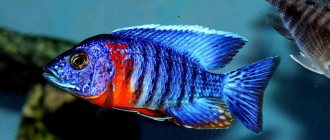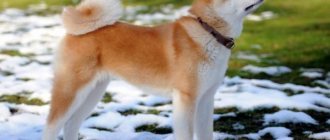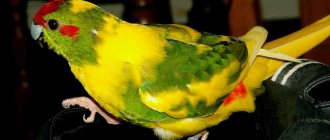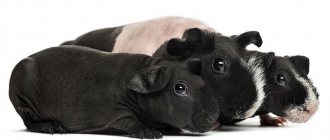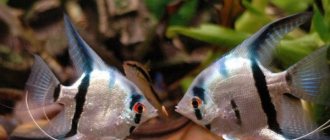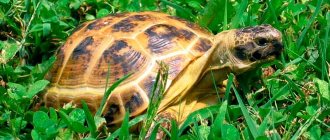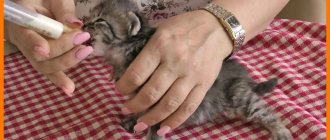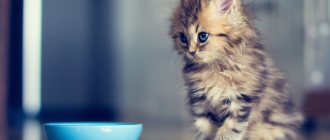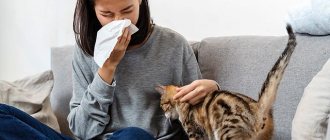There are hundreds and thousands of different cat breeds in the world, some have thick fur, some have long ears, others have no fur at all. Such diversity leads to the fact that people are completely lost in the abyss of ignorance in matters of proper care and nutrition for both small kittens and adult cats.
The topic of our article today will concern the preparation of the correct diet for kittens of the Kuril Bobtail breed.
General recommendations for feeding a Kurilian Bobtail kitten
Have you purchased a Kuril Bobtail kitten and want to raise a healthy, strong, powerful, large cat or a healthy, strong cat? Then read these GENERAL recommendations for feeding Kurilian Bobtail kittens .
Let me remind you that you need to feed the kitten:
- up to 3-4 months - 5-6 times
- from 4 to 9 months – 4 times
- after 10 months - 2-3 times (depending on what you feed)
Feeding a Kuril Bobtail kitten should be predominantly natural products:
- raw, lean, well-frozen meat: beef/veal, horse meat, turkey, chicken; offal;
- fish products - low-fat fish only in boiled form. Preference should be given to oceanic fish species (with white meat). You can have boiled squid and shrimp. Fish cannot be the main food product and should be given no more than 2 times a week;
- an egg (yolk only), boiled or raw, depending on the cat’s taste, no more than 2 times a week; You can have a quail egg (you can have it whole (white + yolk)), but also no more than 2 times a week;
- fermented milk products (it is better to give sour cream, yogurt, cottage cheese, yogurt (without flavorings))
Of the by-products, the rumen of ruminants has the greatest nutritional value; moreover, it contains vitamins, and its villi contain valuable microorganisms necessary for the functioning of the gastrointestinal tract. It should be given raw, but purchased only from trusted places so as not to end up with a low-quality product. Liver has less nutritional value; it cannot be given raw; it must be boiled for 5 minutes or at least scalded (liver can be given no more than 2 times a week).
You can add various porridges from the following cereals to the food with meat: buckwheat, oatmeal, barley, wheat (but not millet!), rice, but always cooked in milk, since rice boiled in water or broth can cause constipation in cats. BUT do not forget that CATS are PREDATORS and they desperately need meat. If you make porridge the main thing in your diet, nothing worthwhile will grow. You need to stick to the ratio of meat + porridge for carnivores.
Don't forget that your kitten needs vitamins and minerals for healthy growth (for example: calcium is a MUST!).
Of the special feeds produced by various companies, Premium and Super Premium class feeds are recommended. Dry food should not form the basis of a Kuril Bobtail kitten’s diet; it can be given as an additive to the main diet. Canned food should make up no more than 25% of the main diet; never feed with economy-class food (Whiskas, Kittecat and the like)). The basis of the diet is MEAT.
IMPORTANT (!): it is imperative to “breed” ready-made (professional) food and “natural” food according to time. Under no circumstances should the kitten be allowed to mix (eat dry food and meat at the same time)!
Sometimes kittens eat vegetables, fruits or greens, you need to encourage these desires, as well as plant grass at home so that they can get vitamins with it and cleanse their stomach.
The kitten will grow up and begin to change from a child's fur coat to an adult one, then vomiting clots of fur, which he licks from himself, is possible. The fur will come out in vomit (sometimes) and feces. If this does not happen and the fur does not come out with feces, then you need to buy a special paste to dissolve the hair and give it as written in the instructions included with the tube of paste.
ATTENTION! A cat's healthy body always has an excellent appetite . Even if your pet is naughty and does not eat the food offered, he should continue to beg for food or be curious about what you eat. Cats love to eat, keep your pet in “sports shape” and do not overfeed.
Refusal of food, especially your favorite one, is a signal of alarm, a sign that not everything is all right with your pet.
DO NOT ATTEMPT TO TREAT THE KITTEN YOURSELF! If your kitten is sick, contact your veterinarian!
These are very general feeding recommendations. The Breeder of your kitten should explain to you in more detail about what, how and in what quantities (in what proportions).
Important(!): the kitten grows/develops, and whether the kitten grows up healthy, strong, and pedigree depends on how correctly the Breeder fed it and how correctly you feed it!
If you purchased a Kuril Bobtail kitten from our Zvezda Kuril nursery, we will tell you everything in detail: what, how and when to feed it. In the future, we will suggest and adjust nutrition as necessary. ALL Kuril owners - graduates of the Zvezda Kuril nursery - receive consultations on all issues related to their pets, constantly, at any time of the day, free of charge. Call.
If you are just thinking about buying a Kuril Bobtail kitten, then take a look at the “Kittens for You” section .
Who knows, maybe one of our kids - Kurilchikov - is waiting for you!
Cat food
Eating dry pads and fresh meat or fish at the same meal will provoke pathologies of the gastrointestinal tract.
Only the highest quality food is suitable for the hunting breed - Royal Canin, Orijen, Pro Plan or Hill's. You can buy dry rations or wet canned food, but such meals should not be frequent. Nutritious dry mixtures from the economic line are strictly prohibited, as they can lead to allergies, pathology of the gastrointestinal tract and kidney failure. Whiskas and Kitty Kats are especially dangerous.
What to feed a Kurilian Bobtail kitten?
There are hundreds and thousands of different cat breeds in the world, some have thick fur, some have long ears, others have no fur at all. Such diversity leads to the fact that people are completely lost in the abyss of ignorance in matters of proper care and nutrition for both small kittens and adult cats.
The topic of our article today will concern the preparation of the correct diet for kittens of the Kuril Bobtail breed.
History of the origin of the Kuril breed
global $ads_google;
//data-ad-slot=”2475549904″ $ads_google = empty($ads_google) ? false : true; ?> if ($ads_google == false) {?> $ads_google = true; ?> } ?> The ancestors of the Kuril Bobtails have lived side by side with people on the Kuril Islands since ancient times. The Kurils loved big aboriginal cats for their homely, gentle disposition and hunting skills. Thus, Kuril cats protected their two-legged neighbors from rats and other pests. They say that by uniting in a pack, wild short-tailed animals can defeat a small bear. In addition, the bobtail is not afraid of water and is able to catch a six-kilogram fish on its own.
Unlike their Japanese “relatives,” the Kurilian Bobtail remained in the shadows almost until the end of the last century. From time to time, strange, massive pets appeared on the mainland. They were brought back from long-distance missions by military personnel and geologists. There, in a foreign land, tamed animals saved their supplies and things from aggressive rodents. Filled with gratitude to the island cats, the travelers took the friendly rat catchers to their homes.
In all respects, the Kurilian Bobtail was an attractive pet with a simple origin story. From their cat relatives, the Kurils have inherited only the best qualities. Siberian cats “awarded” them with a large body with powerful bones and a wide muzzle. From their Japanese relatives, the Russian island aborigines inherited a short tail, keen hearing, strong limbs and a peaceful character. But an important difference between domestic bobtails and foreign cats is their naturally shortened tail, which does not lead to genetic diseases.
Bobtails from the Kuril Islands were first noticed as a breed in the 1980s by L. Ivanova and T. Bocharova. Soon after scientists studied new cats and prescribed a breed standard, short-tailed cats became popular all over the world. While the Americans have been trying to breed similar pets for more than 20 years. And suddenly these healthy creatures were found in their natural environment on the islands in Russia.
In the second half of the 1990s, the breed was officially registered by the first world association. The animal, which looks like a mixture of a Japanese bobtail and a Siberian cat, immediately became the winner of many European exhibitions.
General information about adaptation and diet
Finding the right food for a Kurilian Bobtail kitten is as difficult as climbing Everest. This issue must be approached with all possible care, because any mistake can turn into a disaster.
It is worth saying that representatives of this breed are quite demanding in terms of nutrition, let alone small fluffy balls. For kittens, there is generally a whole list (on several sheets) of various taboos and restrictions. They relate to both the timing of meals and its composition.
Character and habits
Kurilian Bobtails are friendly and playful, very curious and active. There are many dog-like traits in their behavior. For example, these cats run after a toy thrown to them and can bring it back in their teeth, click their claws on the floor covering, wave their tail when they are happy, and when they are angry about something, they can make twitching movements with their entire skin.
Bobtails are very loyal to their owners, but they can choose not one, but two people as their owner, and treat them with equal adoration. From their wild ancestors, cats of this breed have inherited quite pronounced independence, cunning, which is most manifested in unique hunting habits, courage, assertiveness and territoriality (the cats do not tolerate the presence of foreign cats and dogs on their territory, but they get along quite well with “their own” from the domestic pack ).
“Smokers” have well-developed intellect and intuition; in general, they are distinguished by a stable psyche and balance. They do not panic without extreme reason, love to play with their owners and children, do not leave marks in the apartment, and quickly become accustomed to the litter box.
It is quite possible to keep a “smoker” not just as a pet, but as an assistant on the farm, because thanks to their guarding and hunting qualities, cats of this breed perfectly protect the farm from rodents and small-sized foreign animals (birds of prey, martens).
Porridge diet
The first thing you need to start feeding your cat is various cereals. First, you should provide food with semolina porridge with milk. Starting with a low-fat and thin porridge, you can gradually increase the thickness of the product.
Over time, you can switch to “harder” cereals: rolled oats and finely ground buckwheat porridge. As a result, the kitten will be able to properly digest foods made from whole grain components.
Choosing a place and dishes
The main requirements for cat dishes: stability and sufficient capacity. The Kurilian Bobtail should have at least two bowls. Food is placed in one of them, and clean, fresh drinking water is poured into the other every day.
Cat dishes are made from different materials:
- Plastic. This cookware has the lowest cost. It is light and washes well. Plastic bowls come in a variety of shapes and colors. Some plates come with a special stand that resembles a tray. It protects the floor from food that the bobtail might pull out of the bowl.
- Metal. Stainless steel bowls are durable and easy to clean. There are several varieties of such containers on sale: with a stand, with anti-slip rubber, etc.
- Ceramics. These bowls are quite heavy and fragile and can break if dropped. But this dishware has an advantage - it does not impart any foreign taste or smell to the water and food. Due to their weight, ceramic bowls do not roll all over the floor. There are plates on sale in a variety of colors, many with attractive and funny designs.
The height of the sides of the bowl is very important. For dry food, it is better to use deeper and more capacious dishes. For natural food or canned food, bowls with low sides are more suitable. In both cases, the base must be wide enough.
An oval or round bottom shape is most preferred, as square or other shaped plates may be uncomfortable for the kitten.
REFERENCE! Another rule is that each type of food should have its own bowl.
When choosing a place and dishes, it is necessary to take into account the breed characteristics. Kurilian Bobtails are very sociable, so the plates should be placed in a common kitchen, where the kitten will eat together with the owners. You should not move your animal’s bowls around the house; the place for them should be stationary.
It is better to place cat dishes on a special mat or tray. Wash bowls separately from human plates and mugs. You should not use detergents for this, just use a sponge and hot water.
Dairy
After the kitten grows up, you can decide to introduce fermented milk products into the diet. However, to begin with, it is worthwhile to gradually adapt the small ventricle to new food. Calcined cottage cheese is perfect for these purposes, which almost anyone can make.
You just need to add a small spoon of calcium chloride to boiling milk, wait for specific flakes to form and strain through a sieve. This way you can get a tender curd that is perfect for your baby.
After some time, it is quite possible to give the kitten ready-made fermented milk products:
Baby food from popular domestic manufacturers is also perfect.
Bobtail care
Caring for a Kuril breed cat includes a standard set of hygiene procedures, regardless of the length of the coat and other individual characteristics. The only difference: a short-haired cat creates fewer problems during shedding.
- The owner of a purebred animal must periodically inspect the ears. To remove dirt, use a regular cotton pad and a special lotion (you can buy it at a pet store), which allows you to carefully clean the ears of wax, and at the same time carry out effective disinfection.
- No special care is required for the eyes; a smart cat copes with this hygiene procedure on its own. If brownish accumulations are detected in the corner of the eyes, you can carefully clean them with cotton wool dipped in warm tea without brewing or in a special solution.
- To trim overgrown claws, a nail cutter is a practical tool for creating a beautiful manicure for cats.
- It is not necessary to bathe your pet often; 1-2 bath procedures per month are enough. To thoroughly clean thick fur, you can use a special cat shampoo. After washing, the animal is dried with a towel. Next, you need to comb out the shedding undercoat. After the bath, the cat looks a little unusual. His fur becomes unnaturally fluffy, but after 2-3 days the usual appearance will be restored.
To eliminate fleas and reduce the risk of infection with helminths and ticks during street walks, you can use pharmaceutical products for animals. Every pet store has effective medications designed for the age and weight of the animal.
Meat delicacies
Adding meat products to your diet should be approached responsibly.
There are a number of “holy” truths that should be followed for the proper growth and development of the baby:
- Meat and fish products can only be given boiled.
- The serving should be small pieces, preferably in the form of minced meat.
- Under no circumstances should you give meat every day. Alternate foods.
- It is better to completely exclude pork from the menu, as well as liver and giblets.
- Chicken and turkey liver are allowed in limited quantities.
Character of cats of this breed
In terms of friendliness, this cute pet is comparable to a dog, recognized as man's best friend. Despite the fact that the bobtail treats all family members with love and affection, the cat will definitely choose an authoritative owner, whom he will serve at every opportunity.
The breed is distinguished by unwavering loyalty to its owner, great trust and impeccable affection. The favorite pastime of a Kuril breed cat is active games with the chosen owner in nature or in the comfort of home. A cute animal experiences boundless joy when it receives attention. He will be happy to take part in outdoor games with other family members.
The Kuril cat easily adapts to a new environment, he is not afraid of moving or changing his residence, the main thing is that his beloved owner is nearby. If for some reason a purebred pet is kept outside for a long time, it will not disappear. And upon returning to the cozy home of its owners, it will even bring prey, showing its natural hunting skill.
Cats of this breed are not picky and undemanding; they are easy and comfortable to be with. If the owner does not have time to pay attention to his four-legged friend, the bobtail will definitely find entertainment for itself, although some of them may not be appreciated by the household.
A purebred pet will happily play on the highest shelves in the house or explore the owner's closet with clothes. And if there are other animals in the family, the Kurilian Bobtail will quickly make friends with its “competitor” and even begin to attract its neighbor in the living space to joint games.
Kurilian Bobtails are real intellectuals! They are smart and quick-witted, understand the owner’s commands, learn quickly and try to meet the owner’s requirements. If desired, the pet can be taught to fetch certain things in its teeth, which is more relevant for dogs. He is even ready to perform various tricks. An easily trainable cat is a real find for lovers of unusual and smart pets!
CHAPTER III. FEEDING.. Kurilian Bobtail
A Kurilian Bobtail kitten has appeared in your home. What to feed the “Kurilets”?
In the wild, the Kuril Bobtail eats what it can get itself. The basis of its diet consists of: small game, small rodents and fish. For vitamins in their natural habitat, cats eat various plants, bark, some types of berries and even mushrooms.
Experts stubbornly advise not to mix natural food and industrial food, that is, either you prepare natural food for your pet (meat, cottage cheese, eggs), or your pet’s main diet will be dry food, and everything else will be given only as treats in small portions and infrequently.
We take the second option as a basis - dry food. And there are at least three reasons for this:
First:
the composition of dry food is optimally balanced for the animal and does not require additional vitamins and microelements necessary for the proper development of the Maine Coon. After all, when we offer an animal boiled chicken and cottage cheese, we never know exactly how much benefit it received.
The second reason:
The risk of getting food poisoning is much higher if we feed our pet food from the store. If a person’s gastrointestinal tract can still cope with a chicken raised three times faster than it should be, then the cat will react to such a dinner immediately, and she will have loose stools, and you will have unexpected expenses in the form of a bill from the veterinary clinic. This is the best case scenario.
Third reason:
ease of use of dry food. You don't need to boil anything, cut it, store it for three days, or smell it for freshness. They checked the expiration date, opened it, poured it in, sealed it hermetically and that’s it.
Vitamins and supplements in a kitten's diet
If you feed your kitten natural products, you need to introduce vitamins and supplements into the diet. Natural vitamin supplements for:
- Meat and bone meal.
- Fish, chicken, beef liver.
- Greens, vegetables, fruits.
- Sunflower oil, olive oil.
- Brewer's yeast.
- Soft, boiled cartilage.
Pharmacy vitamin supplements:
- Fish fat.
- Feed tricalcium phosphate.
- Omega-3, Omega-6.
- B vitamins.
In addition to vitamins and microelements, the kitten should receive taurine, which is found in the following products:
- Turkey.
- Rabbit.
- Chicken heart, liver.
- Beef heart.
- Pork, ham, trimmed of fat, after deep freezing.
- Pork liver, heat-treated.
- Ocean fish, shellfish.
- Raw red fish.
- Homemade live yogurt.
- Whole milk.
To make their lives easier, many owners give their pets industrial vitamin complexes. The drugs can be purchased at a veterinary pharmacy or pet store. Industrial vitamins help support metabolism and prevent dental diseases.
So, if you chose Dry food.
We do not advise you to buy cheap dry food, as they have a low content of natural ingredients. Once you have brought your kitten into your home, the best option is to continue feeding it the same food that the breeder fed it to avoid any possible upsets due to a sudden change in food. In the future, you can choose food for him at your discretion, but definitely not lower than premium class. Do not suddenly transfer the kitten to another table. Add new food gradually and monitor the animal's reaction.
Never feed your bobtail or any other cat a mixture of dry food from different manufacturers, as this can lead to various kinds of allergic reactions, calcium-phosphorus imbalance, etc. The only thing we can afford is to add a handful to the food food (from the same manufacturer) to remove hair from the cat’s body. Removing hair from the body is a cat’s natural need. During the period of seasonal molting (spring, autumn), this need becomes higher than usual. It happens that a cat can’t cope and needs help. To do this, pet stores sell food or special “treats” for removing hair for cats. However, do not forget that food tolerance is individual for each individual cat.
Dry food should be freely available; do not pour too much into the bowl, as the food dries out and loses its attractiveness. Only if you leave the house for the whole day can you add more. The Kurilian Bobtail eats little by little, but often and, as a rule, does not overeat.
Drinking regime
Regardless of the type of food - industrial or natural, it is important to maintain a drinking regime. The kitten's water needs to be changed every day. The Kurilian Bobtail drinks less than 250 ml of water per day. It is especially important to ensure sufficient water intake if your pet eats only dry products.
If a kitten drinks little water, you should find out the reasons for this phenomenon. Your baby may not like the bowl of liquid or the quality of the water. Insufficient fluid intake can lead to the development of a number of diseases of the digestive and urinary system in an adult cat.
Natural products:
Meat is raw, lean, well frozen (at least 3 days): beef/veal, horse meat, turkey, chicken, offal.
We buy it, divide it into portions, and freeze it. Before feeding, we take out a portioned piece, defrost it, cut it into strips, not very finely, so that the cat does not forget how to chew. We recommend cutting into strips at least 1 cm wide and at least 5 cm long - this way the “Kurilets” will be able to “tear” a piece, which helps strengthen and develop the jaws.
Meat is desirable in a bobtail's diet, but not all animals eat it. If he doesn’t eat, don’t insist.
Fish: low-fat varieties only when boiled. Preference should be given to oceanic fish species (with white meat). You can have boiled squid and shrimp. Fish cannot be the main food product and should be given no more than 2 times a week.
Chicken eggs (yolk only), boiled or raw, depending on the cat’s taste, no more than 2 times a week; You can have a quail egg (you can have the whole white + yolk), but also no more than 2 times a week.
fermented milk products such as sour cream, yogurt, cottage cheese, and unflavored yogurt.
It is not advisable to feed too variedly at one feeding; do not mix natural products with industrial feeds. Remember that the Kuril Bobtail is an aboriginal breed, that is, not artificially bred, but wild, tamed by man. Cats are predators, and their diet, even in nature, is not very varied.
Water should always be freely available and changed at least twice a day.
Unique appearance and characteristics of the breed
The first breed standard for “Kurilians” was developed by the SFF in 1991. To date, several felinological organizations, including the World and International Cat Federations, have adopted significantly different standards. Disputes about a single standard are still ongoing.
There are two recognized varieties based on coat length:
- Shorthair subtype . The coat is close to the body, with outer hair predominating. The undercoat is moderate.
- Semi-longhaired subtype . Integumentary and guard hairs predominate, and the undercoat is dense. To get a high mark at the exhibition, it is desirable that semi-long hair forms tassels at the tips of the ears, voluminous “pants” and a “collar”.
The colors of the "Kurilians" are very diverse. Animals come in solid colors, two-tone and tortoiseshell, marbled, spotted or with a brindle pattern on their coats.
But there are also colors that are not recognized by most felinological organizations, these are:
- shades of chocolate and lilac,
- cinnamon,
- faun,
- ticked,
- acromelanistic (the exception is the Assolux system, within its framework there are catteries with this form of color).
The main distinguishing feature of the breed is a short (3-8 cm, if you do not take into account the hair) deformed tail, which is unique for each individual.
Subtypes of tail structure:
- Stump . It is represented by 2-8 short and deformed vertebrae, as if strung one on top of the other. Their joints are motionless, the fractures feel like bumps to the touch. Sometimes the last 1-2 vertebrae are set aside and partially retain mobility.
- Spiral . It is a movable or semi-movable articulation of 3-15 vertebrae, with creases at an acute angle, in the form of a spiral or hook. The tail can be directed in any direction, curled over the back, at the base adjacent to the sacral region.
- Panicle . Includes 5-10 vertebrae, fractures form obtuse angles. The tail may outwardly look quite long (about 1/3 of the standard length of a cat's tail), the fur partially hides the deformities, but when palpated, obvious creases are revealed. The articulation of the caudal vertebrae is movable, semi-movable or combined.
- Retracted bobtail . The first 5–7 vertebrae do not have deformities, and the tip is bent and broken (usually in the shape of a spiral). This type is considered a breed fault when evaluated at exhibitions.
A tail shorter than 3 cm and longer than 12 cm is also considered a reason for a decrease in points when evaluating the exterior. And the absence of a tail or a straight tail is a reason for disqualification at exhibition competitions.
The body of the “Kuril” is compact in size, the muscles are well developed, the body is raised, the back is slightly arched. The hind legs are longer than the front legs, the limbs are strong. Males weigh on average 5-8 kg, females - 2.5-4 kg. By the way, their wild relatives are much lighter, especially males - their weight does not exceed 4 kg.
Another unique feature of the breed is its partially non-retractable claws. It is not known for certain what led to this mutation. This is probably due to the characteristics of hunting behavior and lifestyle. Wild bobtails are excellent fishermen, capable of catching fish in the water and from the shore.
The head is massive, trapezoidal. The muzzle is wide, with distinct contours of the cheekbones and chin. The ears are wide, rounded at the tips. The eye shape is round, their eye color should be in harmony with the color type.
For cats participating in exhibition competitions in the beginner class, a document confirming import from the Kuril Islands is required.
Vitamins:
Since the Kuril Bobtail is a large breed, with heavy bones, it grows up to two to three years, and during the growth period its body especially requires an additional source of calcium and multivitamin complexes. Supplements are especially important if you are a follower of natural nutrition.
We recommend the following vitamin complexes:
- “Gelobon” (“Zhelobon” or “Gelobon” are called differently) is a source of calcium.
- The drug “Cat mineral tabs” (Canina) is a multivitamin complex from one of the best companies producing drugs for cats and dogs, but it is not available everywhere. We give the course - a break for a month and then the course again. It can be problematic to give, then you can hide it in a piece of meat. You can become bolder and get into your pet’s mouth by placing the tablet on the root of the tongue. If you do this quickly, the pet will not even understand what happened.
- Vitamins with taurine and biotin or “Seva” - for the prevention of cardiovascular diseases
- Vitamins for wool (“Biofar”, “Canina”, “Exce”l) are most relevant during seasonal shedding, they facilitate and speed up this process. If you notice that the animal’s fur is losing its condition, then also take the course.
For all medications, read dosage instructions. Not necessarily on paper, but on the Internet.
When they ask me: “How many years does a Kurilian Bobtail live?”, I ask a question for reflection: “How many years does a person live?” Of course, this is a rhetorical question; everything will depend on the conditions under which your pet is kept. But there is still a limit. Everyone has their own. And I answer: “Your friend will live as long as you feed him correctly.”
Proper nutrition for cats is the key to a happy pet and a calm life for the owner.
Types of bobtail breed:
- American - a large cat with long or short hair;
- Thai - with excellent almond-shaped eyes of a rich blue color;
- Japanese - a graceful animal with a clearly athletic build;
- the Karelian cat has longer hair on the tail;
- The Kurilian representative (breed description below) is an affectionate, friendly and very cute cat with an amazing character and loyalty.
Domestic cats of natural origin - bobtail, have ancestors from the Kuril Islands, Kamchatka and Sakhalin. They have well-developed bones, the length of the coat is semi-long or short, and the tail is of unusually short length.
